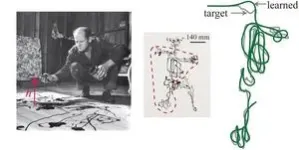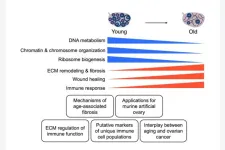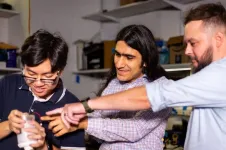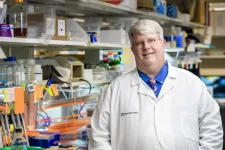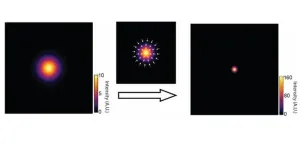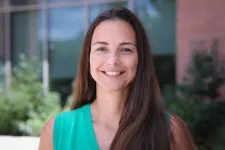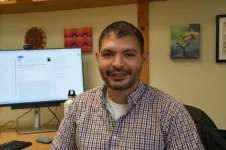(Press-News.org) Can a machine be trained to paint like Jackson Pollock? More specifically, can 3D-printing harness the Pollock's distinctive techniques to quickly and accurately print complex shapes?
“I wanted to know, can one replicate Jackson Pollock, and reverse engineer what he did,” said L. Mahadevan, the Lola England de Valpine Professor of Applied Mathematics at the Harvard John A. Paulson School of Engineering and Applied Sciences (SEAS), and Professor of Organismic and Evolutionary Biology, and of Physics in the Faculty of Arts and Sciences (FAS).
Mahadevan and his team combined physics and machine learning to develop a new 3D-printing technique that can quickly create complex physical patterns — including replicating a segment of a Pollock painting — by leveraging the same natural fluid instability that Pollock used in his work.
The research is published in Soft Matter.
3D and 4D printing has revolutionized manufacturing but the process is still painstakingly slow.
The issue, as it usually is, is physics. Liquid inks are bound by the rules of fluid dynamics, which means when they fall from a height, they become unstable, folding and coiling in on themselves. You can observe this at home by drizzling honey on a piece of toast.
More than two decades ago, Mahadevan provided a simple physical explanation of this process, and later suggested how Pollock could have intuitively used these ideas to paint from a distance.
Today, most 3D and 4D printing techniques place the print nozzle millimeters from the surface, all but eliminating the dynamic instability of the liquid stream.
But Mahadevan has a motto: use the physics, instead of avoiding it.
“We wanted to develop a technique that could take advantage of the folding and coiling instabilities, rather than avoid them,” said Gaurav Chaudhary, a former postdoctoral fellow at SEAS and first author of the paper.
Pollock composed his famous drip paintings by placing a canvas on the floor and drizzling, pouring, dripping and splashing paint onto it from above. To the untrained eye, his technique may seem haphazard, but Pollock always claimed he had complete control over the flow of the paint.
Dubbed “action painting”, Pollock drew in the space above the canvas – creating shapes in the air which would fall to the canvas below.
“If you look at traditional 3D printers, you supply them a path from point A to point B and the nozzle deposits ink along that specified path,” said Chaudhary. “But Pollock’s approach of throwing paint from a height meant that even if his hand was moving in a specific trajectory, the paint didn’t follow that trajectory because of the acceleration gained from gravity. A small motion could result in a large splatter of paint. Using this technique, you can print larger lengths than you can move because you gain this free acceleration from gravity.”
The question was, how to control it?
To learn how to manipulate the nozzle to print at a distance and control fluid coiling, Mahadevan and Chaudhary, along with co-authors Stephanie Christ, a former student in Mahadevan's Soft Math Lab and A. John Hart, Professor of Mechanical Engineering at MIT, combined the physics of coiling with deep reinforcement learning, which is an algorithmic approach to improving performance iteratively. Mahadevan and his team used techniques developed by Petros Koumoutsakos, Herbert S. Winokur, Jr. Professor of Computing in Science and Engineering at SEAS.
“With deep reinforcement learning, the model can learn from its mistakes and get more and more accurate with each trial,” said Chaudhary.
Using this technique, the researchers printed a series of complex shapes, painting like Pollock and even decorating a cookie with chocolate syrup.
The researchers used simple fluids for this research, but the approach could be expanded to include more complex fluids, such as liquid polymers, pastes and various types of foods.
“Harnessing physical processes for functional outcomes is both a hallmark of intelligent behavior, and at the heart of engineering design. This little example suggests, once again, that understanding the evolution of the first might help us be better at the second,” said Mahadevan.
As the research continues, there is no telling where Mahadevan may look for inspiration next.
“When you’re in Maha’s lab, nothing is off the table,” said Chaudhary.
The research was supported in part by the National Science Foundation under grant DMR-2011754 and the Simons Foundation.
END
Reverse engineering Jackson Pollock
Researchers combine physics and machine learning to use Pollock’s drip paint technique for quick and accurate 3D printing
2023-10-31
ELSE PRESS RELEASES FROM THIS DATE:
Proteomic quantification of native and ECM-enriched mouse ovaries reveals an age-dependent fibro-inflammatory signature
2023-10-31
“Overall, our study provides novel insight into how reproductive aging impacts the murine ovarian proteome and ECM.”
BUFFALO, NY- October 31, 2023 – A new priority research paper was published on the cover of Aging (listed by MEDLINE/PubMed as "Aging (Albany NY)" and "Aging-US" by Web of Science) Volume 15, Issue 20, entitled, “Proteomic quantification of native and ECM-enriched mouse ovaries reveals an age-dependent fibro-inflammatory signature.”
The ovarian microenvironment becomes fibrotic and stiff with age, in part due to increased collagen and decreased hyaluronan. However, the extracellular matrix ...
Hix, Lajoie elected Fellows of the American Physical Society
2023-10-31
Physicists William Raphael “Raph” Hix of the Department of Energy’s Oak Ridge National Laboratory and John Lajoie, who will join ORNL on Nov. 6 from Iowa State University, have been elected Fellows of the American Physical Society.
The society works to advance and spread physics knowledge via research journals, scientific meetings, education, outreach, advocacy and international activities. It represents more than 50,000 members, including physicists in government, academia and industry worldwide.
Hix, leader of the Theoretical and Computational ...
Illinois Tech researchers receive award from peoples gas for solution optimizing efficiency of legacy steam radiators
2023-10-31
CHICAGO—October 31, 2023—Researchers at Illinois Institute of Technology (Illinois Tech) have been recognized by Peoples Gas with the Innovation Strategies and Technologies Award for their Battery-Operated Radiator Control (BORC) system, a groundbreaking solution to optimize the efficiency of manually operated radiators.
The researchers, Assistant Professor of Architectural Engineering Mohammad Heidarinejad and Arthur W. Hill Endowed Chair in Sustainability Brent Stephens, had the insight that traditional steam radiators are ...
Next-generation influenza B vaccines provide broad and long-lasting protection against flu viruses in preclinical tests
2023-10-31
Recent preclinical results indicate novel next-generation vaccine candidates developed at Cleveland Clinic protect against multiple strains of influenza and last longer than vaccines currently in use.
The vaccines are part of Cleveland Clinic's global vaccine research program, led by Ted Ross, PhD, Global Director of Vaccine Development at Cleveland Clinic. Published in Scientific Reports, the study credits the preclinical success of the influenza B vaccines to novel technology called Computationally Optimized Broadly Reactive ...
Digitizing books can spur demand for physical copies
2023-10-31
ITHACA, N.Y. – Book publishers cried foul – in the form of numerous legal challenges – nearly two decades ago when the Google Books project digitized and freely distributed more than 25 million works.
The publishers argued that free digital distribution undermines the market for physical books, but new research from Cornell University’s Imke Reimers and a collaborator reveals that the opposite – increased demand for physical books, through online discovery – could be true.
Reimers, an associate professor in the Charles H. Dyson School of Applied Economics and Management, and Abhishek Nagaraj, assistant professor ...
New database shines spotlight on decades of solar mirror research
2023-10-31
The U.S. Department of Energy's National Renewable Energy Laboratory (NREL) is preparing to unveil a database containing the results of exposure experiments on solar reflectors conducted over more than four decades. The publicly available Solar Mirror Materials Database (SMMD) will contain information from thousands of solar mirror samples from more than a hundred suppliers that have been subjected to outdoor tests and laboratory environments.
Typically used for concentrating solar-thermal power, these mirrors were installed and tested in Phoenix, ...
Human input boosts citizens’ acceptance of AI and perceptions of fairness, study shows
2023-10-31
Increasing human input when AI is used for public services boosts acceptance of the technology, a new study shows.
The research shows citizens are not only concerned about AI fairness but also about potential human biases. They are in favour of AI being used in cases when administrative discretion is perceived as too large.
Researchers found citizens' knowledge about AI does not alter their acceptance of the technology. More accurate systems and lower cost systems also increased their acceptance. Cost and accuracy of technology ...
Sharper images: A breakthrough in microscopy resolution
2023-10-31
Obtaining high-resolution images in the world of microscopy has long been a challenge. Deconvolution, a method to enhance image clarity, often amplifies noise between the sample and the image. Researchers at Boston University recently developed a novel deblurring algorithm that avoids these issues, improving the resolution of images with photon intensity conservation and local linearity.
As reported in the Gold Open Access journal Advanced Photonics, the innovative deblurring algorithm is adaptable to various fluorescence microscopes, requiring minimal assumptions about the emission point spread function (PSF). It works on both a sequence of raw images and even a single image, enabling ...
FSU-led research shows shifting nesting timing not enough to prevent fewer sea turtle hatchlings
2023-10-31
New research led by a Florida State University professor shows that potential adaptive responses by sea turtles, such as shifting the timing of when they nest, may not be enough to counteract the projected impacts from climate change on hatchling production.
Warmer temperatures cause lower hatchling success and a greater percentage of female turtles, both of which can disrupt the viability of a species. Sand temperatures at sea turtle nesting sites globally are projected to increase by about 0.6 degrees Celsius to ...
Study aims to remove barriers to veterans seeking mental health services
2023-10-31
Suicide and mental health distress disproportionately affect veterans in the United States. According to a report from the Substance Abuse and Mental Health Services Administration, more than 5 million veterans suffered from these adverse behavioral health issues in 2020. That same year, after adjusting for age and sex differences in the population, the U.S. Department of Veterans Affairs (VA) estimated that veterans were 57.3 percent more likely to commit suicide than non-veterans.
While the Veterans ...
LAST 30 PRESS RELEASES:
Research alert: Spreading drug costs over the year may ease financial burden for Medicare cancer patients
Hospital partnership improves follow up scans, decreases long term risk after aortic repair
Layered hydrogen silicane for safe, lightweight, and energy-efficient hydrogen carrier
Observing positronium beam as a quantum matter wave for the first time
IEEE study investigates the effects of pointing error on quantum key distribution systems
Analyzing submerged fault structures to predict future earthquakes in Türkiye
Quantum ‘alchemy’ made feasible with excitons
‘Revoice’ device gives stroke patients their voice back
USF-led study: AI helps reveal global surge in floating algae
New method predicts asthma attacks up to five years in advance
Researchers publish first ever structural engineering manual for bamboo
National poll: Less than half of parents say swearing is never OK for kids
Decades of suffering: Long-term mental health outcomes of Kurdish chemical gas attacks
Interactional dynamics of self-assessment and advice in peer reflection on microteaching
When aging affects the young: Revealing the weight of caregiving on teenagers
Can Canada’s health systems handle increased demand during FIFA World Cup?
Autistic and non-autistic faces may “speak a different language” when expressing emotion
No clear evidence that cannabis-based medicines relieve chronic nerve pain
Pioneering second-order nonlinear vibrational nanoscopy for interfacial molecular systems beyond the diffraction limit
Bottleneck in hydrogen distribution jeopardises billions in clean energy
Lung cancer death rates among women in Europe are finally levelling off
Scientists trace microplastics in fertilizer from fields to the beach
The Lancet Obstetrics, Gynecology, & Women’s Health: Taking paracetamol during pregnancy does not increase risk of autism, ADHD or intellectual disabilities, confirms new gold-standard evidence review
Taking paracetamol during pregnancy does not increase risk of autism, ADHD or intellectual disabilities
Harm reduction vending machines in New York State expand access to overdose treatment and drug test strips, UB studies confirm
University of Phoenix releases white paper on Credit for Prior Learning as a catalyst for internal mobility and retention
Canada losing track of salmon health as climate and industrial threats mount
Molecular sieve-confined Pt-FeOx catalysts achieve highly efficient reversible hydrogen cycle of methylcyclohexane-toluene
Investment in farm productivity tools key to reducing greenhouse gas
New review highlights electrochemical pathways to recover uranium from wastewater and seawater
[Press-News.org] Reverse engineering Jackson PollockResearchers combine physics and machine learning to use Pollock’s drip paint technique for quick and accurate 3D printing

